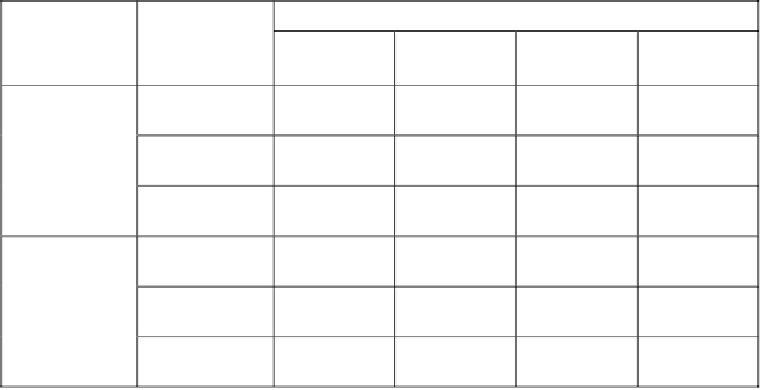Environmental Engineering Reference
In-Depth Information
the situation is quite different in intact cells, which are capable of
de novo
protein synthesis.
On the first place, the damage induced by either visible or UV-B illumination applied
separately is significantly smaller than that observed in the presence of protein synthesis
inhibitor (Figure 8, right panel). This is in agreement with previous findings showing that
repair of damaged PSII centers is a constitutive process during visible and UV-B
illumination
26,35
. Even more important is the observation that the presence of low intensity
visible light prevents the UV-induced loss of PSII activity.
At higher light intensities the UV-induced damage was not prevented, or even
enhanced, and the difference between the slope of the measured and calculated inactivation
curves became slower or disappeared as observed at 650 or 1300 PEm
-2
s
-1
intensity,
respectively (Table I).
Table I.
The slopes of the PSII inactivation curves under separate and simultaneous UV-B and
visible illumination
. Experiments were performed by using
Synechocystis
6803 cells as shown in
Figure 8 and the slopes of the damage curves were calculated from the semi-logarithmic plots. UV-B
intensity was 6 PEm
-2
s
-1
in all experiments, but the intensity of the visible light varied between
130-1300 PEm
-2
s
-1
. In the last column the values show the predicted slopes of inactivation curves
calculated by the assumption of independent damaging mechanisms.
Illumination Protocol
Visible light
intensity
Visible
alone
UV
alone
UV+ Visible
measured
UV+ Visible
calculated
130PEm
-2
s
-1
0.3*10
-3
1.6*10
-3
-0.5*10
-3
2.0*10
-3
Synechocystis
PCC 6803
cells
1.8*10
-3
1.7*10
-3
1.7*10
-3
3.5*10
-3
650PE m
-2
s
-1
1300PE m
-2
s
-1
3.4*10
-3
1.7*10
-3
4.0*10
-3
4.4*10
-3
1.4*10
-3
4.2*10
-3
5.0*10
-3
5.6*10
-3
130PE m
-2
s
-1
Synechocystis
PCC 6803
cells +
lincomycin
325PE m
-2
s
-1
2.3*10
-3
2.3*10
-3
4.5*10
-3
4.7*10
-3
3.5*10
-3
2.8*10
-3
5.3*10
-3
6.4*10
-3
1300PE m
-2
s
-1
The role of DNA damage in PSII repair
DNA is a well known target of UV-B radiation not only in non-pigmented cells, but
also in photosynthetic organisms. As discussed above the repair of UV-damaged PSII
proceeds via
de novo
protein synthesis, which requires the transcription of DNA encoding
the D1 and D2 reaction center subunits. Accumulation of damaged DNA could obviously
hamper the transcription process and retard the protein-synthesis-dependent repair of PSII.
In order to create a suitable experimental system to study this question we inactivated the
slr0854
gene encoding a type-I photolyase enzyme in
Synechocystis
6803. This mutant was
unable to grow under UV-B light complemented with visible illumination, condition which
did not affect the wild-type cells (Figure 9). However, the photolyase deficient cells could

Search WWH ::

Custom Search